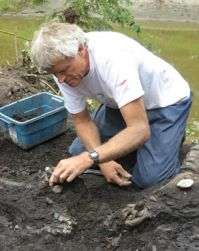Edmonton city site was dinosaur dining room

A dinosaur bone bed in southwest Edmonton that served as a feeding area for the direct ancestor of Tyrannosaurus rex has revealed that two dinosaurs, thought to have lived in different eras, actually lived at the same time.
Scientists digging for bones at the site this year discovered fossils of Edmontosaurus and Saurolophus this year.
"We weren't expecting it," said Dr Phil Currie, a world-renowned paleontologist with the University of Alberta Faculty of Science. Until this find in Edmonton, the Saurolophus and Edmontosaurus had only been found at different levels in the rocks near Drumheller.
In Drumheller, Saurolophus fossils are never found in the same localities as Edmontosaurus. According to Currie, finding fossils of both plant-eating species together "means they were here at the same time. It's a new discovery."
Currie and his team of students and volunteers from BP Canada Energy Company also found a lot of teeth from Daspletosaurus, a meat-eating dinosaur from the tyrannosaurus family and a direct ancestor of Tyrannosaurus rex. The finding means Daspletosaurus used the spot as a feeding area.
Like most other meat-eating dinosaurs, Daspletosaurus replaced their teeth every year and a half to two years. The cycle would begin as their teeth loosened. Just like humans, a new tooth would grow and their body would dissolve away the root of the old tooth leaving them with a loose crown.
"Daspletosaurus couldn't really take their little hands and wiggle their teeth," explained Currie. "When they were feeding on big dinosaurs, the loose teeth would fall out and get mixed in with the bones of the animals they were eating."
Currie and his team also found tooth marks on some of the bones. "All Tyrannosaurus had really powerful jaws. They could bite through bone," said Currie, who also expects to eventually find Albertosaurus fossils in the bone bed. Albertosaurus is another meat-eating dinosaur that lived in the same area and time - the late Cretaceous period between 80 and 73 million years ago - as the others.
Currie calls the bone bed site one of the best sites in the world. "This is the kind of thing you see in some of the best dinosaur sites in the world. There are a few sites in China where we have thick bone beds like this."
Research on the site will continue for many years. While there are many Edmontosaurus bone beds from Alaska to South Dakota, Currie says the animal really hasn't been studied much. "We don't even know how many species we're dealing with. We're not sure how long it lived, we're not sure what kind of environments it lived in. There's a whole bunch of questions relating to the Edmontosaurus that we can solve if we put the time into it," he said.
He added that Phil Bell, an MSc student who is doing his thesis on this material, will study the bone bed to see what else it reveals.
Source: University of Alberta





















